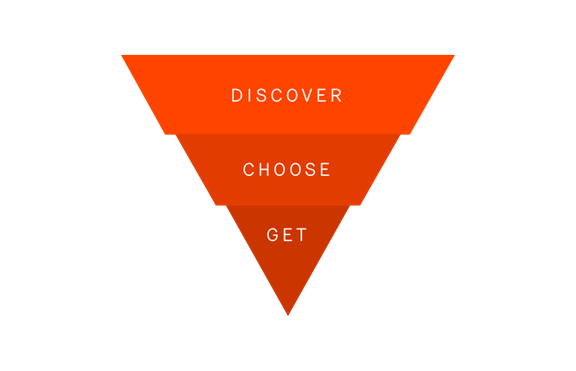For each of the challenges above we have pulled together examples below of retailers already harnessing the power of computer vision to differentiate themselves in their industry.
1. Computer vision helps create inspirational experiences that aren’t one-size-fits all
At the broadest end of the funnel, creating new demand for products through inspiration has been a difficult and resource consuming task for retailers. For a customer too, it can be difficult to articulate the kinds of products they might be interested in through traditional categories of products. What Computer Vision lends to inspiration is the ability for customers to register their preferences though hundreds of visual images that can come in the form of a ‘look’ or style. This is a particularly valuable opportunity for fashion retailers with huge and ever-changing product inventories. Companies such as Topshop and Thread allow customers to take an online quiz, selecting pictures of models in different outfit styles and trends. At the end they are presented with a curated feed of clothes based purely on their chosen preferences.
Computer Vision has also allowed retailers to automatically generate new bundles of products based on an individual's tastes.This has revolutionised traditional methods of cross-selling products, that for a long time have been restricted to ‘because you bought this, you might like this…’. Clothing retailer ABOF achieves this by training their recommendation engine on their own catalogue photos, global fashion trends and customer purchase data. In real-time they are able to generate and visually offer up a full outfit recommendation of other products to complete the look of whatever product a customer is looking at.
2. Computer vision helps filter products that match my personal preferences
We are living in an increasingly visual world, taking more pictures, sharing more visual content and consuming more visual media than ever before. It’s no surprise that a large amount of our purchase inspiration is coming from the world around us in the images we are exposed to day-by-day. Computer vision has made it possible to accurately identify items that exist inside any image and direct you to finding similar products online. Now with just an image customers can narrow down their search for products that match their personal preferences, creating an exciting new use case for retailers.
EasyJet have applied computer vision to encourage discovery through social channels. Their Look&Book app allows users to upload Instagram screenshots of destinations they want to go to. The app is able to identify the destination location and the best flights to get you there.
ASOS recently launched their ‘Style Match’ tool insider their app. It allows users to take a picture or upload an image and search ASOS’s 85k strong inventory for any products that match the same look, saving hours of browsing time.
3. Computer vision helps me jump to products I want right now
At the narrow end of the purchase funnel, discovery becomes a lot more focused. A customer might be very clear about the type of product and distinct features they’re looking for, but find it hard to find that specific product. It’s the reason millions tap the Amazon icon, because they are confident in finding the right products with a single search.
Computer vision makes images searchable, easily identifying the name of products through their visual features. Home Depot found customers would come to their stores looking for a DIY part they didn’t know the name of, amongst 100s of different variants. Using the image search feature within their app customers are able to take a picture of the item, identify and purchase it in a few taps.
Using the same technology, Kin + Carta partnered with Marks & Spencer to develop the Mobile Pay Go service. The service revolutionises the in-store experience for M&S Food customers, enabling users to beat the queues by scanning products, paying and leaving the store in one seamless experience.
Computer vision and AI are also allowing traditional text-based searches to become a lot more powerful. Products can now be searched based on their visual features such as colour, fit or style without the need to tag the details of every item manually. This allows customers to use more natural search terms to find the items they want, for example 'find me a yellow corner sofa that fits four people’.
It’s time to start experimenting with AI
AI solutions are no longer reserved for big businesses with deep pockets and data scientists. Giants such as Google have democratised AI s with simplified developer platforms. While personalisation platforms such as Quibit have made it simple to integrate more segmented journeys into existing websites. These advancements have meant it has never been easier for retailers to experiment and implement AI solutions.
At Kin + Carta, we’re experimenting with services built on AI and computer vision online and in-store for some of the UK’s biggest retailers.

